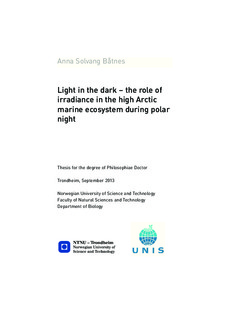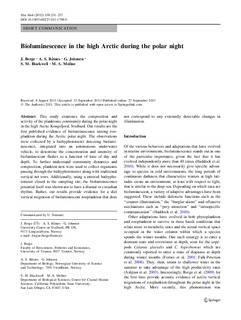| dc.contributor.author | Båtnes, Anna Solvang | nb_NO |
| dc.date.accessioned | 2014-12-19T13:13:23Z | |
| dc.date.available | 2014-12-19T13:13:23Z | |
| dc.date.created | 2013-10-31 | nb_NO |
| dc.date.issued | 2013 | nb_NO |
| dc.identifier | 661037 | nb_NO |
| dc.identifier.isbn | 978-82-471-4408-4 (printed ver.) | nb_NO |
| dc.identifier.isbn | 978-82-471-4409-1 (electronic ver.) | nb_NO |
| dc.identifier.uri | http://hdl.handle.net/11250/245354 | |
| dc.description.abstract | In this thesis, I studied the role of light in the Arctic marine ecosystem during the polar night; a time of year when it appears completely dark to the human eye. I have studied patterns of diel vertical migration (DVM) of zooplankton, and the vision of selected Arctic organisms was investigated by using hyperspectral imaging as well as behavioural experiments. During polar night, patterns of bioluminescence and DVM were mapped in Kongsfjorden, Svalbard, using an autonomous underwater vehicle (AUV) as well as zooplankton net hauls. Bioluminescence was, as the first registration during the polar night, documented throughout the water column. Diel changes in bioluminescence over depth were observed, with a significantly greater proportion of the more intense flashes occurring in surface layers during night and at depth during day. In addition, investigations using acoustic backscatter as well as plankton net hauls supported that the larger zooplankton, like Calanus spp., performed DVM in Kongsfjorden during polar night. To investigate the spectral characteristics of the eyes of different organisms, the eyes of live specimens of different copepod and amphipod species were characterised using a hyperspectral imager. The spectral properties of the eyes were found to match the light climate of their habitats, sympagic and shallow-living pelagic species probably absorbing in blue and some in green wavebands, while deeper-living pelagic and hyperbenthic species absorbed mainly in blue. The sensitivity to ambient wavelengths may be part of the explanation to how organisms can stay active during the polar night, when ambient irradiance is very limited. Calanus spp. is a genus highly important to the Arctic marine ecosystem, and was selected for studies of potential response to extremely low irradiance levels. An experimental setup was developed to investigate their phototactic behaviour (behavioural response to irradiance). For laboratory cultured C. finmarchicus (originating from Trondheimsfjorden), the lowest irradiance levels eliciting a phototactic response were in the range of 1-10×10-6 μmol photons m-2 s-1. Using parameters from spring phytoplankton bloom conditions, when attenuation of light is high, the irradiance threshold levels for C. finmarchicus were estimated to correspond to 48-57 m depth in a fjord (Trondheimsfjorden) and 158-186 m in open ocean (Norwegian Sea), which matched with reported depth ranges of natural C. finmarchicus populations. The phototactic behaviour of Calanus spp. sampled during polar night was investigated, to start revealing the visual capabilities of polar night acclimated organisms. The copepods showed highest sensitivity towards blue and green wavebands, responding to irradiance as low as 0.3-4.0×10-6 μmol photons m-2 s-1, while the corresponding values for red was about three orders of magnitude higher. Correlating the lowest threshold level for response with estimations of polar night irradiance with depth, it was suggested that Calanus spp. may respond to irradiance from the night sky down to approximately 40-50 m, moonlight to 100-140 m, and aurora borealis down to 60-100 m depth. Thus, irradiance may be the proximate cue for the observed DVM patterns, and it was suggested that the background irradiance from the sun, moonlight, as well as aurora affects the pelagic ecosystem during the polar night. | nb_NO |
| dc.language | eng | nb_NO |
| dc.publisher | Norges teknisk-naturvitenskapelige universitet, Fakultet for naturvitenskap og teknologi, Institutt for biologi | nb_NO |
| dc.relation.ispartofseries | Doktoravhandlinger ved NTNU, 1503-8181; 2013:151 | nb_NO |
| dc.relation.haspart | Berge, Jørgen; Båtnes, Anna Solvang; Johnsen, Geir; Blackwell, Susan; Moline, Mark A.. Bioluminescence in the high Arctic during the polar night. Marine Biology. (ISSN 0025-3162). 159(1): 231-237, 2012. <a href='http://dx.doi.org/10.1007/s00227-011-1798-0'>10.1007/s00227-011-1798-0</a>. | nb_NO |
| dc.relation.haspart | Moline, MA; Berge, J,; Johnsen, G,; Båtnes, AS; Blackwell, SM. Bioluminescence flash kinetics characterize pelagic community structure. . | nb_NO |
| dc.relation.haspart | Båtnes, Anna S.; Thoen, Hanne H.; Berge, Jørgen; Johnsen, Geir. Hyperspectral imaging of a crustacean’s eye provides insight into its spectral sensitivity and general ecology. . | nb_NO |
| dc.relation.haspart | Miljeteig, Cecilie; Olsen, Anders Johny; Båtnes, Anna S.; Altin, Dag; Nordtug, Trond; Alver, Morten O.; Speed, James D. M.; Jenssen, Bjørn Munro. Sex and life stage dependent phototactic response of the marine copepod <em><em><em>Calanus finmarchicus </em></em></em>Gunnerus (Copepoda: Calanoida). . | nb_NO |
| dc.relation.haspart | Båtnes, Anna S.; Miljeteig, Cecilie; Berge, Jørgen; Greenacre, Michael; Johnsen, Geir. Orchestrated movements of copepods in the dark conducted by the Moon, Sun, and aurora borealis. . <a href='http://dx.doi.org/10.1007/s00300-013-1415-4'>10.1007/s00300-013-1415-4</a>. | nb_NO |
| dc.title | Light in the dark – the role of irradiance in the high Arctic marine ecosystem during polar night | nb_NO |
| dc.type | Doctoral thesis | nb_NO |
| dc.contributor.department | Norges teknisk-naturvitenskapelige universitet, Fakultet for naturvitenskap og teknologi, Institutt for biologi | nb_NO |
| dc.description.degree | PhD i biologi | nb_NO |
| dc.description.degree | PhD in Biology | en_GB |


